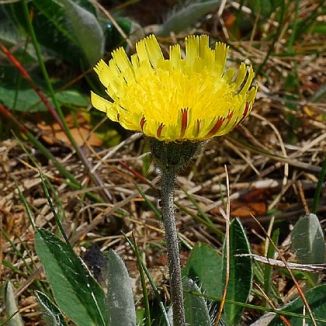This perennial Hawkweed is best identified for its lovely downy, spatulate leaves. All borne in a basal rosette, the stems and the untoothed leaves are green and hairy above with soft, white, shaggy down below. Rising from the centre of the rosette is the leafless plant stem bearing a solitary, lemon yellow flowerhead (20-30mm across). This flowerhead is comprised of numerous ray florets, the back of the outer rays often being striped red. This wildflower blooms from May to October and grows widely in dry grassy places, on old stone walls, sand dunes and waste ground. It puts out creeping runners and forms mats, the runners decaying after the new daughter plant is established. It also produces fruit attached to a pappus. This is a native plant which belongs to the family Asteraceae.
My earliest record of this plant is in 1979 above Sorrento Bay, Co Dublin and I photographed it in the Burren, Co Clare in 2007.
If you are satisfied you have correctly identified this plant, please submit your sighting to the National Biodiversity Data Centre




